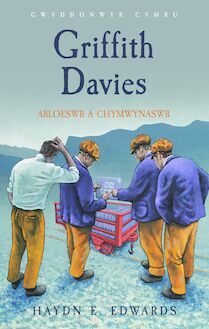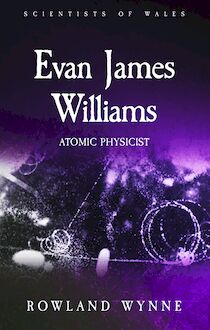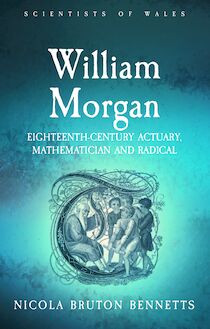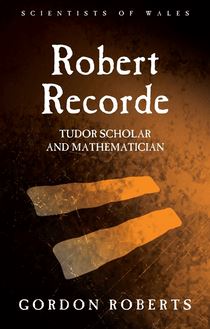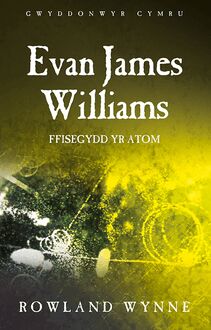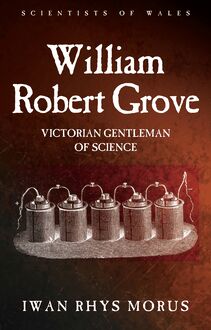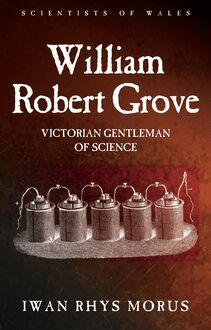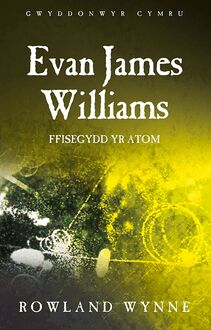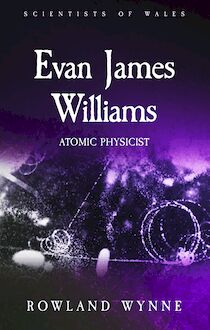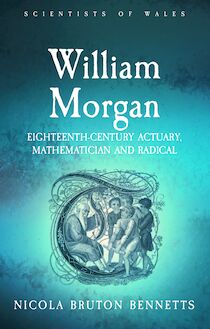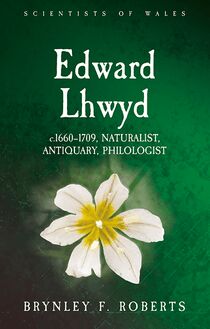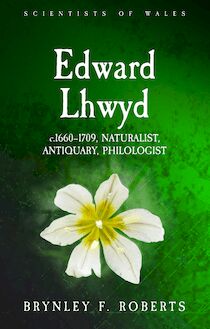-
 Univers
Univers
-
 Ebooks
Ebooks
-
 Livres audio
Livres audio
-
 Presse
Presse
-
 Podcasts
Podcasts
-
 BD
BD
-
 Documents
Documents
-
- Cours
- Révisions
- Ressources pédagogiques
- Sciences de l’éducation
- Manuels scolaires
- Langues
- Travaux de classe
- Annales de BEP
- Etudes supérieures
- Maternelle et primaire
- Fiches de lecture
- Orientation scolaire
- Méthodologie
- Corrigés de devoir
- Annales d’examens et concours
- Annales du bac
- Annales du brevet
- Rapports de stage
La lecture à portée de main
Vous pourrez modifier la taille du texte de cet ouvrage
Découvre YouScribe en t'inscrivant gratuitement
Je m'inscrisDécouvre YouScribe en t'inscrivant gratuitement
Je m'inscrisEn savoir plus
Vous pourrez modifier la taille du texte de cet ouvrage
En savoir plus

Description
To meet William Morgan is to encounter the eighteenth-century world of finance, science and politics. Born in Bridgend in 1750, his heritage was Welsh but his influence extended far beyond national borders, and the legacy of his work continues to shape life in the twenty-first century. Aged only twenty-five and with no formal training, Morgan became actuary at the Equitable, which was then a fledgling life assurance company. Known today as ‘the father of the actuarial profession’, his pioneering work earned him the Copley Medal, the Royal Society’s most prestigious award. His interests covered a wider scientific field, and his papers on electrical experiments show that he unwittingly constructed the first X-ray tube. Politically radical, Morgan’s outspoken views put him at risk of imprisonment during Pitt’s Reign of Terror. This biography, using unpublished family letters, explores Morgan’s turbulent private life and covers his outstanding public achievements.
‘William spent 56 years at the Equitable Life Assurance Company, where he learnt how to understand and manage financial risk. In 1789, for his work on the mathematics of life assurance, he was awarded the Copley Medal, the Royal Society’s most prestigious decoration. Subsequent generations have hailed him as ‘the father of the actuarial profession’ – recognition of his having established many of the rules and standards on which the science is based.’
Read more about this on page 6 of the Booklaunch https://edition.pagesuite-professional.co.uk/html5/reader/production/default.aspx?pubname=&edid=eacd7c66-df5c-4335-86ee-cad05c826bda
Acknowledgements
List of Illustrations
William Morgan Family Tree
Prologue
Chapter 1: Bridgend
Chapter 2: Newington Green
Chapter 3: Blackfriars
Chapter 4: 1780 – Flaming June
Chapter 5: At War
Chapter 6: A Beautiful Green Light
Chapter 7: Risk and Reward
Chapter 8: Verbal Fisticuffs
Chapter 9: Stamford Hill
Chapter 10: A Stupendous Event
Chapter 11: Bunhill Fields
Chapter 12: A Radical Friend
Chapter 13: A Trumpet of Liberty
Chapter 14: Trial for High Treason
Chapter 15: Pitt’s Gagging Acts
Chapter 16: Invasion, Panic and Mutiny
Chapter 17: The Reign of Terror
Chapter 18: Diaspora
Chapter 19: The Price of Success
Chapter 20: Family, Celebrations and Calamities
Chapter 21: A Costly Peace
Chapter 22: Rise, Progress, Misrepresentation
Chapter 23: A Fragment
Chapter 24: Final Years
Chapter 25: Afterwards
Chapter 26: Epilogue
Bibliography
Sujets
Informations
| Publié par | University of Wales Press |
| Date de parution | 15 septembre 2020 |
| Nombre de lectures | 0 |
| EAN13 | 9781786836205 |
| Langue | English |
| Poids de l'ouvrage | 4 Mo |
Informations légales : prix de location à la page 0,1074€. Cette information est donnée uniquement à titre indicatif conformément à la législation en vigueur.
Extrait
SCIENTISTS OF WALES
William Morgan
SCIENTISTS OF WALES
Series Editor
Gareth Ffowc Roberts
Bangor University
Editorial Panel
John V. Tucker
Swansea University
Iwan Rhys Morus
Aberystwyth University
SCIENTISTS OF WALES
William Morgan
EIGHTEENTH-CENTURY ACTUARY, MATHEMATICIAN AND RADICAL
NICOLA BRUTON BENNETTS
© Nicola Bruton Bennetts, 2020
All rights reserved. No part of this book may be reproduced in any material form (including photocopying or storing it in any medium by electronic means and whether or not transiently or incidentally to some other use of this publication) without the written permission of the copyright owner except in accordance with the provisions of the Copyright, Designs and Patents Act 1988. Applications for the copyright owner’s written permission to reproduce any part of this publication should be addressed to the University of Wales Press, University Registry, King Edward VII Avenue, Cardiff CF10 3NS.
www.uwp.co.uk
British Library Cataloguing-in-Publication Data
A catalogue record for this book is available from the British Library.
ISBN 978-1-78683-618-2
eISBN 978-1-78683-620-5
The right of Nicola Bruton Bennetts to be identified as author of this work has been asserted in accordance with sections 77, 78 and 79 of the Copyright, Designs and Patents Act 1988.
The publisher acknowledges the financial support of the Books Council of Wales.
The publisher has no responsibility for the persistence or accuracy of URLs for any external or third-party internet websites referred to in this book, and does not guarantee that any content on such websites is, or will remain, accurate or appropriate.
Cover image: Feature of early nineteenth-century life assurancepolicy of the Society for Equitable Assurances,shown withpermission of the Institute and Faculty of Actuaries (RC 000243); all rights reserved.
In memory of my brother, Simon Bruton (1947–2019)
CONTENTS
Series Editor’s Foreword
Acknowledgements
List of Illustrations
William Morgan Family Tree
Prologue: The Tea Caddy Letters
1 Bridgend
2 Newington Green
3 Blackfriars
4 1780 – Flaming June
5 At War
6 A Beautiful Green Light
7 Risk and Reward
8 Verbal Fisticuffs
9 Stamford Hill
10 A Stupendous Event
11 Bunhill Fields
12 A Radical Friend
13 The Trumpet of Liberty
14 Trial for High Treason
15 Pitt’s Gagging Acts
16 Invasion, Panic and Mutiny
17 The Reign of Terror
18 Diaspora
19 The Price of Success
20 Family, Celebrations and Calamities
21 A Costly Peace
22 Rise, Progress, Misrepresentation
23 A Fragment
24 Final Years
25 Afterwards
Epilogue
Notes
Bibliography
SERIES EDITOR’S FOREWORD
W ales has a long and important history of contributions to scientific and technological discovery and innovation stretching from the Middle Ages to the present day. From medieval scholars to contemporary scientists and engineers, Welsh individuals have been at the forefront of efforts to understand and control the world around us. For much of Welsh history, science has played a key role in Welsh culture: bards drew on scientific ideas in their poetry; renaissance gentlemen devoted themselves to natural history; the leaders of early Welsh Methodism filled their hymns with scientific references. During the nineteenth century, scientific societies flourished and Wales was transformed by engineering and technology. In the twentieth century the work of Welsh scientists continued to influence developments in their fields.
Much of this exciting and vibrant Welsh scientific history has now disappeared from historical memory. The aim of the Scientists of Wales series is to resurrect the role of science and technology in Welsh history. Its volumes trace the careers and achievements of Welsh investigators, setting their work within their cultural contexts. They demonstrate how scientists and engineers have contributed to the making of modern Wales as well as showing the ways in which Wales has played a crucial role in the emergence of modern science and engineering.
RHAGAIR GOLYGYDD Y GYFRES
O ’r Oesoedd Canol hyd heddiw, mae gan Gymru hanes hir a phwysig o gyfrannu at ddarganfyddiadau a menter gwyddonol a thechnolegol. O’r ysgolheigion cynharaf i wyddonwyr a pheirianwyr cyfoes, mae Cymry wedi bod yn flaenllaw yn yr ymdrech i ddeall a rheoli’r byd o’n cwmpas. Mae gwyddoniaeth wedi chwarae rôl allweddol o fewn diwylliant Cymreig am ran helaeth o hanes Cymru: arferai’r beirdd llys dynnu ar syniadau gwyddonol yn eu barddoniaeth; roedd gan wŷr y Dadeni ddiddordeb brwd yn y gwyddorau naturiol; ac roedd emynau arweinwyr cynnar Methodistiaeth Gymreig yn llawn cyfeiriadau gwyddonol. Blodeuodd cymdeithasau gwyddonol yn ystod y bedwaredd ganrif ar bymtheg, a thrawsffurfiwyd Cymru gan beirianneg a thechnoleg. Ac, yn ogystal, bu gwyddonwyr Cymreig yn ddylanwadol mewn sawl maes gwyddonol a thechnolegol yn yr ugeinfed ganrif.
Mae llawer o’r hanes gwyddonol Cymreig cyffrous yma wedi hen ddiflannu. Amcan cyfres Gwyddonwyr Cymru yw i danlinellu cyfraniad gwyddoniaeth a thechnoleg yn hanes Cymru, â’i chyfrolau’n olrhain gyrfaoedd a champau gwyddonwyr Cymreig gan osod eu gwaith yn ei gyd-destun diwylliannol. Trwy ddangos sut y cyfrannodd gwyddonwyr a pheirianwyr at greu’r Gymru fodern, dadlennir hefyd sut y mae Cymru wedi chwarae rhan hanfodol yn natblygiad gwyddoniaeth a pheirianneg fodern.
ACKNOWLEDGEMENTS
T his book began with letters from the past which introduced me to distant members of my family. I am forever grateful to John Morgan and the late David Perry, whose scholarly genealogical research has not only enabled me to identify all the letter writers and place them in context, but has also provided nuggets of family history which have fleshed out the bare facts of the family tree. Further detail has been provided by Paul Frame, initially through his excellent biography of William’s uncle, Richard Price, and then through his generosity in sharing his research material. His encouragement has been wonderfully sustaining, and his creation of the Richard Price Society has introduced me to fellow enthusiasts whose knowledge and support have been invaluable. I send Paul and all the members my very warm thanks.
The archive of the Equitable Assurance Society, now housed at the Institute of Actuaries at Staple Inn, is a rich seam of material relating to William’s fifty-six years as an actuary. David Raymont, the librarian at the Institute, has spent many hours patiently guiding me through their records, minutes of meetings, and other documents, ever tactful about my slow grasp of actuarial procedures. As well as a catalogue of the archive material, he provided me with details of eighteenth-century policies and policyholders, giving me a valuable insight into the mores of the time. He also arranged expert help on actuarial science by giving me an introduction to David Forfar, with whom I have had an extended tutorial by means of an exchange of emails. I am indebted to David Forfar for his lucid explanations of the science of big numbers and other concepts, and for his historical accuracy concerning the development of actuarial science.
My very limited science education meant that William’s electrical experiments presented me, not to mention those who undertook to coach me, with an enormous challenge. I am immensely grateful to Peter Midgley who gave me a crash course in basic electricity, and to Tony Carrington who gave me step-by-step teaching to explain X-rays and, in particular, William’s experiment. John Tucker has continued the tuition and much, much more, being generous with his time and endlessly patient. I could not have completed this book without his help.
William’s varied interests took me to a wide range of places for research. I had help and encouragement everywhere I went and I send my thanks to the very many people who gave me their time and the benefit of their expert knowledge. Janet Payne checked all the apprenticeship records at the Worshipful Society of Apothecaries as well as giving me a tour of the impressive Apothecaries’ Hall. The librarians at the Wellcome Trust helped me to fill in the details of William’s life as a medical student. At the Royal Society I was shown William’s original X-ray paper alongside the contemporary letters and papers which gave a fuller picture of the scientific ideas of the time.
I had many happy and useful trips to the British Library, where help was always on hand, similarly at the Glamorgan Archive, where I was particularly grateful that permission was obtained for me to view William’s letters in the Merthyr Mawr collection. The University of Bristol Library provided much background material, in particular records of the state trials. The librarians at Stamford Hill Library went to a great deal of trouble to help me discover what had happened to William’s house and, at the Hackney Archive, I was shown maps and a wealth of material relating to the time when the house was a YMCA hostel. Vicky Clubb at the Cadbury Research Library, where the YMCA archive is housed, gave me a number of further leads and a route to some delightful photographs. Rosemary Harden at the Bath Costume Museum helped to date my own photograph of Stamford Hill by examining the clothes and hairstyles of the people in the grainy picture.
Alex Allardyce gave me a comprehensive tour of Newington Green which included a visit to the chapel and, most excitingly, one to number 54 where, as an architect, he showed me how to read detail such as the dado in a first-floor room. At Hornsey, Janet Owen and her archive team at the Hornsey Historical Society made me very welcome; they provided details of the Morgan family vault and showed me where to find it. Then staff at the London Metropolitan Archive found the faculty which confirmed the extraordinary inscription about the removal of Sarah Travers’s remains.
Ann Thwaite, biographer of both Philip and Edmund Gosse, gave me he
-
 Univers
Univers
-
 Ebooks
Ebooks
-
 Livres audio
Livres audio
-
 Presse
Presse
-
 Podcasts
Podcasts
-
 BD
BD
-
 Documents
Documents
-
Jeunesse
-
Littérature
-
Ressources professionnelles
-
Santé et bien-être
-
Savoirs
-
Education
-
Loisirs et hobbies
-
Art, musique et cinéma
-
Actualité et débat de société
-
Jeunesse
-
Littérature
-
Ressources professionnelles
-
Santé et bien-être
-
Savoirs
-
Education
-
Loisirs et hobbies
-
Art, musique et cinéma
-
Actualité et débat de société
-
Actualités
-
Lifestyle
-
Presse jeunesse
-
Presse professionnelle
-
Pratique
-
Presse sportive
-
Presse internationale
-
Culture & Médias
-
Action et Aventures
-
Science-fiction et Fantasy
-
Société
-
Jeunesse
-
Littérature
-
Ressources professionnelles
-
Santé et bien-être
-
Savoirs
-
Education
-
Loisirs et hobbies
-
Art, musique et cinéma
-
Actualité et débat de société
- Cours
- Révisions
- Ressources pédagogiques
- Sciences de l’éducation
- Manuels scolaires
- Langues
- Travaux de classe
- Annales de BEP
- Etudes supérieures
- Maternelle et primaire
- Fiches de lecture
- Orientation scolaire
- Méthodologie
- Corrigés de devoir
- Annales d’examens et concours
- Annales du bac
- Annales du brevet
- Rapports de stage
